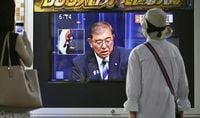Japan is once again on the cusp of political change as Prime Minister Shigeru Ishiba announced his resignation on Sunday, September 7, 2025, following two devastating mid-term election defeats. His departure marks the fourth time in five years that the country will see a new leader, underscoring the ongoing instability within the ruling Liberal Democratic Party (LDP) and the broader challenges facing Japanese politics.
Ishiba’s resignation came just a day before an internal LDP vote that was widely expected to force him out of office. The party, which has governed Japan for all but four years since its founding in 1955, found itself in turmoil after losing its single-party majority in both the lower and upper houses of parliament—a rare and humbling setback for the political juggernaut. According to BBC, Ishiba initially resisted calls to step down, insisting he needed to take responsibility for the party’s losses and deal with an urgent trade deal with the United States. But as party dissent grew louder, Ishiba ultimately bowed to the inevitable, announcing, “Voices had been mounting from within the party that the PM must take responsibility... [and] the writing was on the wall.”
The leadership crisis comes at a particularly fraught moment for Japan. The country is grappling with rising inflation and a cost of living crisis, a weakened yen, and increasingly tense relations with both neighbors and key allies. The LDP’s internal struggles have only compounded these difficulties, with many voters turning away from the party in frustration over corruption scandals and economic stagnation. As Professor James Brown of Temple University Japan told the BBC, “Japanese people are not accustomed to inflation so even a small amount feels shocking. For many ordinary voters, Japan just feels like it’s becoming a poorer country—prices are rising but wages are not going up, and with the yen being so weak, those going abroad would find everything so expensive.”
With Ishiba’s resignation, attention has shifted to the upcoming LDP leadership contest, scheduled for October 4, 2025. According to AFP, the party’s election committee announced that a formal notice for the election would be issued on September 22, with a 12-day campaign period before votes are counted. The contest will be a full-scale affair, involving both the party’s 295 incumbent lawmakers and an equal number of votes proportionally assigned to grassroots members across Japan’s prefectural chapters, for a total of 590 votes. As reported by The Jiji Press, “The full-scale election will include votes by rank-and-file party members and supporters nationwide, as well as by the party’s lawmakers in both chambers of the Diet.” Senior LDP official Ichiro Aisawa emphasized the importance of this broad participation, noting that over one million party members would have a say in the outcome.
This voting system is expected to favor candidates with strong popularity among the party’s rank-and-file and the general public, rather than just the party elite. “In this election, whether the LDP can rise or fall is at stake,” said Shunichi Suzuki, the party’s general affairs chief, at a press conference. Hiroshi Moriyama, the LDP secretary general who served under Ishiba, echoed this sentiment: “I think this presidential election is an important opportunity for our party to make a fresh start... and move forward as a national party for a new era.”
As the leadership race heats up, several high-profile candidates have emerged. Toshimitsu Motegi, a 69-year-old former foreign minister known as the “Trump Whisperer” for his diplomatic skills, was the first to formally join the race on Monday, September 8. According to The Jiji Press, Motegi is expected to hold a press conference to announce his candidacy on Wednesday, September 10. Chief Cabinet Secretary Yoshimasa Hayashi, 64, has also decided to run, while Sanae Takaichi, another 64-year-old veteran and former economic security minister, is preparing her campaign. Takayuki Kobayashi, 50, also a former economic security minister, is considering entering the contest.
Among the frontrunners, Shinjiro Koizumi, the youthful and media-savvy agricultural minister, stands out for his popularity online and his lineage as the son of former Prime Minister Junichiro Koizumi. Sanae Takaichi, if successful, would become Japan’s first female prime minister. Known for her hardline conservative views and opposition to same-sex marriage, Takaichi’s positions align with the LDP’s traditionalist wing. Hayashi, meanwhile, is seen as a steady hand, less flamboyant but more experienced—a possible unifying figure in a party riven by factional strife.
Factionalism has long been a defining feature of the LDP, and it is a key reason for Japan’s rapid turnover of prime ministers. As Professor Brown explained to the BBC, “In terms of government, it’s really only ever been the LDP—so that means the main political competition comes from within the party, rather than from external parties. So within the LDP there are vicious struggles within different factions—they all want their own faction to get the top job. So even though you might be selected as leader, as soon as you’re in office, you have dozens of people maneuvering to try to get you out again.”
Whoever emerges victorious in October will inherit a daunting set of challenges. The new leader must not only unify a weakened and divided party but also stem the drift of conservative voters toward far-right parties such as Sanseito, which has capitalized on discontent with the LDP. As Dr. Tomohiko Taniguchi, a professor at the University of Tsukuba, observed, “Prime Minister Ishiba was considered not conservative enough by many supporters of Abe. They think that he just doesn’t have the nationalistic views on history, he doesn’t have the strong views against China that Abe had.” The rise of Sanseito is seen as a direct consequence of this perceived ideological gap, with many traditional LDP voters seeking a more assertive stance on national issues.
Beyond party politics, the next prime minister will have to navigate fraught international waters. Relations with China, North Korea, and Russia remain tense, especially after a recent “Victory Day” parade in Beijing attended by Kim Jong Un and Vladimir Putin. According to Professor Leif-Eric Easley of Ewha University in Seoul, “Whether the leader is more nationalistic like Takaichi or next-generation-minded like Koizumi... the endurance of trilateral cooperation among Tokyo, Washington, and Seoul will be closely watched after Xi, Putin, and Kim so visibly displayed solidarity in Beijing.” Even Japan’s relationship with its long-term ally, the United States, has shown signs of strain, with President Donald Trump earlier this year demanding that Tokyo pay more for the stationing of American troops.
Despite the high stakes, public sentiment remains skeptical that a new leader will bring real change. “There’s a bit of despair in the public. There’s no great hope that a different leader would make any major difference. For many people, they think it’s just the same old story, just with a different LDP leader,” said Professor Brown.
As the LDP prepares for its October 4 leadership election, all eyes are on whether the party can break its cycle of short-lived prime ministers and chart a new course for Japan. The outcome will not only determine the country’s next leader but could also shape the nation’s political landscape for years to come.


